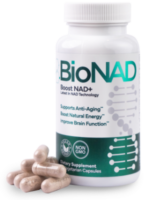Unlocking the Power of NRF2 Activator Benefits

Published October 3, 2024
Achieving optimal health relies on a critical element: NRF2 activators. These powerful agents boost antioxidant production, reduce inflammation, and enhance well-being. Chronic inflammation and oxidative stress affect our health. Understanding NRF2 activators can be transformative.
In this article, we’ll look into the multifaceted NRF2 activator benefits. We’ll also examine their effects on antiviral activity, longevity, oxidative stress, and more.
What Is An NRF2 Activator?
NRF2 activators are compounds that stimulate the production of antioxidants in the body. They boost antioxidant levels, helping minimize inflammation and cellular damage and paving the way for healthier living. These activators are crucial in maintaining the body’s internal balance against oxidative stress.
What Is The Primary Function Of NRF2?
NRF2, or nuclear erythroid-related factor 2, is a crucial protein. It is the ‘master regulator’ of the body’s antioxidant pathway. NRF2 coordinates the production of antioxidant proteins. These proteins help combat free radicals, unstable molecules that can cause cellular damage.
By activating NRF2, the body enhances its ability to repair and defend against various stressors. It’s expressed everywhere all over the body, but mainly in the muscles, kidneys, lungs, heart, brain, and liver.
NRF2 is included in a group of proteins called transcription factors (TF), up to 1,600 in humans. The TFs control which parts of DNA are transcribed into RNA and ultimately translated into proteins. Interestingly, NRF2 controls around 3-5% of a human’s cellular proteins. In simple terms, this is very crucial since TFs are in charge of how your body builds itself and functions.

The Role Of NRF2 In Antiviral Activity
One of the key NRF2 activator benefits is its significant role in combating viral infections. Research indicates that certain viruses, such as HIV, can suppress NRF2 expression. This suppression leads to tissue damage. However, activating NRF2 can help the body mitigate lung tissue damage. It also reduces oxidative stress. This offers potential therapeutic benefits against viruses.
Compounds like sulforaphane can activate NRF2. This activation helps increase antioxidant levels and improves the capability of the immune cells in the lungs. As a result, the body can fight infections more effectively. Additionally, activating NRF2 may be a valuable approach to managing lung issues in people with HIV-1. By supporting NRF2, we can strengthen the body’s natural defenses against viruses.
The Relationship Between NRF2 And Longevity
Aging is a complex process influenced by various factors, including oxidative damage. The Free Radical Theory of Aging specifies that the build-up of free radicals contributes to aging.
NRF2 is known as the “guardian of healthspan.” It enhances longevity by activating pathways that protect against diseases and oxidative damage, promoting a longer and healthier life.

NRF2 And Oxidative Stress
Oxidative stress resembles rusting—a process where unchecked oxidants cause damage. Poor diet, lifestyle stress, and aging increase oxidative stress, necessitating NRF2 activation.
NRF2 activity naturally declines with age. Enhancing this pathway is crucial. It helps maintain antioxidant defense and minimizes cellular damage.
Possible Risks Associated With NRF2 Activators
Although NRF2 activators provide a range of benefits, excessive activation may present risks. In one study, elevated NRF2 activity in cancer patients can result in resistance to chemotherapy.
Some research suggests that overactivation in certain conditions may lead to the formation of arterial plaques. Therefore, it’s best to prioritize natural, whole-food sources for safe and effective NRF2 activation.

What Foods Naturally Activate NRF2?
Nature offers a wealth of foods that activate NRF2. Here are some of the most potent NRF2 activators:
- Cruciferous vegetables include broccoli microgreens, cauliflower, and bok choy. They are rich in sulforaphane, a powerful compound known for its activator properties.
- Rich dark chocolate or cacao nibs
- Herbs and spices include turmeric, yellow mustard, ginger, cloves, cinnamon, and oregano.
- Legumes
- Red wine is known for its high concentration of antioxidants found in grape skins.
- Tea, mainly green and white varieties
Adding these foods can boost your body’s natural antioxidant production. Prioritizing organic options is essential, as they usually have higher antioxidants.
When you eat these antioxidant-rich foods, they scavenge free radicals. They also activate antioxidant proteins, enhancing your overall health.
Additionally, a study indicates that exercise can activate NRF2, improving the body’s response to oxidative stress and potentially boosting NRF2 activator benefits.
The Link Between Sulforaphane And NRF2
Sulforaphane is a compound naturally present in cruciferous vegetables like bok choy, broccoli, and Brussels sprouts. It’s known as the most potent activator of NRF2.
While other activators are available, sulforaphane stands out. It has superior potency and greater bioavailability. Bioavailability is the ability of compounds to enter the bloodstream and affect the body.

Unlocking The Potential Of NRF2 Activators For Optimal Health
Embracing NRF2 activators is a proactive step towards improved health. Understanding their role and knowing the NRF2 activator benefits is vital. Incorporating natural sources into your lifestyle can help you harness their potential. This can combat oxidative stress, support longevity, and enhance overall well-being. With a balanced approach, NRF2 activators can be a cornerstone of a health-conscious lifestyle.

Try BioNAD Now & Experience The Boost!
NAD+ (Nicotinamide Adenine Dinucleotide) is a crucial coenzyme found in every cell of your body, playing a vital role in cellular energy production and metabolism. BioNAD supplements aim to elevate your NAD+ levels, providing numerous health benefits.

About The Author
Meet Corinne Grace, a nurse with a passion for writing. Her expertise lies in health and wellness topics, where she blends academic knowledge with engaging story telling.

This Content Has Been Reviewed For Factual Accuracy
This content has undergone thorough fact-checking by our team of experts. Learn more about the editorial standard for our website here.




